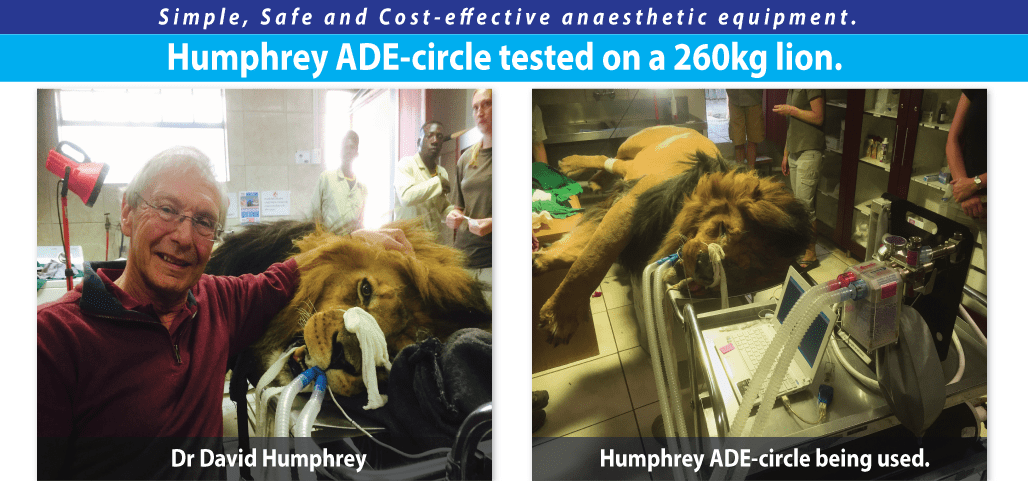
Lion anaesthesia: Lion anaesthesia – with isoflurane and flows less than that used for a 5kg cat: observations by Dr David Humphrey
It’s not often that you get asked to anaesthetize two lions. These are big cats of ±260kg – and in July this year I found out how really fearsome creatures lions are close up – with no cage between you! Nor am I a vet, but a medical anaesthetist drawn into both medical and veterinary anaesthesia. From a research viewpoint the lions were also over 100kg heavier than in any previous procedure using the Humphrey ADE-circle system. Previously in 15 years it had been used routinely in animals ranging from 50gms to 150kg such as birds, cats, dogs and foals to more exotic animals such green mambas, seals, turtles, owls, pelicans and pandas (London zoo). Here was a new challenge!
In theory all that is required is larger apparatus and tubes and an understanding of the physiology of the animal. With recycling, the absolute minimum oxygen requirement for this 260kg lion would be about 5 mℓ/kg/min = 1.3 ℓ/minute. Larger 22mm smooth bore tubes were used. Reassuringly the anaesthetic was monitored with an inline capnograph and an agent monitor. After darting the male lion and bringing it to theatre, intubation was scary with such big canines the size of my little finger. High fresh gas flows of 10 ℓ/min was used to begin with to get the system filled and the lion anaesthetized to a surgical level with isoflurane. All looked stable after 10 minutes and the minor operation began. After another 5 minutes the flow was then reduced litre by litre to a point when it was expected for parameters to start changing. Even at 2 ℓ/min no parameter altered. The flow was finally reduced to that which just kept the reservoir bag full, providing a flow equal to the animal’s oxygen requirements. This flow was just 1.2 ℓ/min and relied on complete and effective carbon dioxide absorption. The main concern with so little isoflurane being added the system was whether the level of anaesthesia would drop due to metabolism of isoflurane and tissue uptake within the animal. In totally uncharted territory I observed that this
did not change at all, and for the remaining duration of the procedure nothing further was changed. At the end the lion was not woken up in theatre – but deepened to allow time to transport it back to enclosure! The second lion – no problem – I was now an expert!
Conclusion: The fresh gas flow was less than that often used for a 5kg cat, some 50 times lighter. The standard ADE-circle can safely be used in lions and probably in most animals up to that mass. However I don’t teach vet staff to use 5 mℓ/kg/min fresh gas flow when recycling – it is doubled it for safety and a leak test must be done before every anaesthetic.
